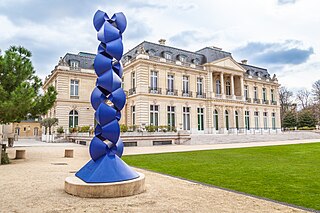
The 16th arrondissement of Paris is the westernmost of the 20 arrondissements of Paris, the capital city of France. Located on its Right Bank, it is adjacent to the 17th and 8th arrondissements to the northeast, as well as to the suburb of Boulogne-Billancourt, Hauts-de-Seine to the southwest. Opposite the Seine are the 7th and 15th arrondissements.

Passy is an area of Paris, France, located in the 16th arrondissement, on the Right Bank. It is adjacent to Auteuil to the southwest, and Chaillot to the northeast.

Louis Vuitton Malletier SAS, commonly known as Louis Vuitton, is a French luxury fashion house and company founded in 1854 by Louis Vuitton. The label's LV monogram appears on most of its products, ranging from luxury bags and leather goods to ready-to-wear, shoes, perfumes, watches, jewellery, accessories, sunglasses and books. Louis Vuitton is one of the world's leading international fashion houses. It sells its products through standalone boutiques, lease departments in high-end departmental stores, and through the e-commerce section of its website. Louis Vuitton merged with Moët Hennessy in 1987 to create LVMH, of which it is a subsidiary.

The Rue du Faubourg Saint-Honoré is a street located in the 8th arrondissement of Paris, France. Relatively narrow and nondescript, especially in comparison to the nearby Avenue des Champs-Élysées, it is cited as being one of the most luxurious and fashionable streets in the world thanks to the presence of major global fashion houses, the Élysée Palace, the Hôtel de Pontalba, the Embassy of Canada, the Embassy of the United Kingdom, as well as numerous art galleries.
A malletier is, in French, literally a trunk-maker, or manufacturer of luggage and suitcases..

The Rue Saint-Honoré is a street in the 1st arrondissement of Paris, France. It is named after the collegial Saint-Honoré church, situated in ancient times within the cloisters of Saint-Honoré.

Jean-François Houbigant was a French perfumer who founded the second oldest perfumery in France. He established a modest shop in 1775 at 57 rue du Faubourg-Saint-Honoré. He chose a basket of flowers to identify the front of his shop and that emblem will remain the symbol of Houbigant through the years.

The Rue du Bac is a street in the 7th arrondissement of Paris. The street, which is 1,150 m long, begins at the junction of the quais Voltaire and Anatole-France and ends at the Rue de Sèvres.

The Maison de Balzac is a writer's house museum in the former residence of French novelist Honoré de Balzac (1799–1850). It is located in the 16th arrondissement at 47, rue Raynouard, Paris, France, and open daily except Mondays and holidays; admission to the house is free, but a fee is charged for its temporary exhibitions. The nearest métro and RER stations are Passy and Avenue du Président Kennedy.
Maison Devambez is the name of a fine printer's firm in Paris. It operated under that name from 1873, when a printing business established by the royal engraver Hippolyte Brasseux in 1826 was acquired by Édouard Devambez. At first the firm specialized in heraldic engraving, engraved letterheads and invitations. Devambez clients included the House of Orléans, the House of Bonaparte and the Élysée Palace. Devambez widened the scope of the business to include advertising and publicity, artists’ prints, luxurious limited edition books, and an important art gallery. The House became recognized as one of the foremost fine engravers in Paris, winning numerous medals and honours. With the artist Édouard Chimot as Editor after the First World War, a series of limited edition art books, employing leading French artists, illustrators and affichistes, reached a high point under the imprimatur A l'Enseigne du Masque d'Or – the Sign of the Golden Mask and with PAN in collaboration with Paul Poiret. Édouard's son, André Devambez, became a famous painter and illustrator after receiving the Prix de Rome.
Moynat is a Parisian trunkmaker, founded in Paris in 1849 by Octavie and François Coulembier. They collaborated with specialist Pauline Moynat in travel goods to open the company's first store at Avenue de l'Opera, France. The house participated in various World's Fairs.

Louis Vuitton was a French fashion designer and businessman. He was the founder of the Louis Vuitton brand of leather goods now owned by LVMH. Prior to this, he had been appointed as trunk-maker to Empress Eugénie de Montijo, wife of Napoleon III.

Paul Albert Laurens was a French painter.

Au Départ, Ltd. is a Parisian trunkmaker founded in Paris in 1834. Au Départ is considered as one of four greatest French trunk-makers alongside Louis Vuitton, Goyard and Moynat.

Revel is a former French brand founded in France in 1851 that manufactured luxury parasols largely for the French expatriates in the former French colonial empire.
Martin-Eloy Lignereux also spelled Martin-Eloi (1751-1809) was a French marchand-mercier or decorative arts dealer. Active in Paris from 1781, he founded "la Maison Lignereux". Lignereux was popular among the upper echelons of society both at home and abroad in his own lifetime, furnishing many stately homes and aristocratic residences throughout Europe.

Count Armand Doria (1824-1896) was a French aristocrat, art collector and patron. He served as the mayor of Orrouy from 1864 to 1896. He acquired a significant collection of impressionist works, including paintings subsequently exhibited in museums in Europe and the United States.
Georges Ferréol Vuitton was the only child of Louis Vuitton and Clemence-Emilie Vuitton, who succeeded his father as head of the Louis Vuitton brand, which is now a brand under the umbrella of the parent company LVMH. Georges is commonly known for his creation of the widely-used LV monogram canvas print, created as an homage to his father and to combat counterfeits. He is also known for making Louis Vuitton products available to purchase internationally. After Georges Vuitton's death in 1936, his son Gaston Louis Vuitton (1883–1970) succeeded him as head of the Vuitton brand.
Aux États-Unis is a Parisian trunkmaker established in 1845.
















